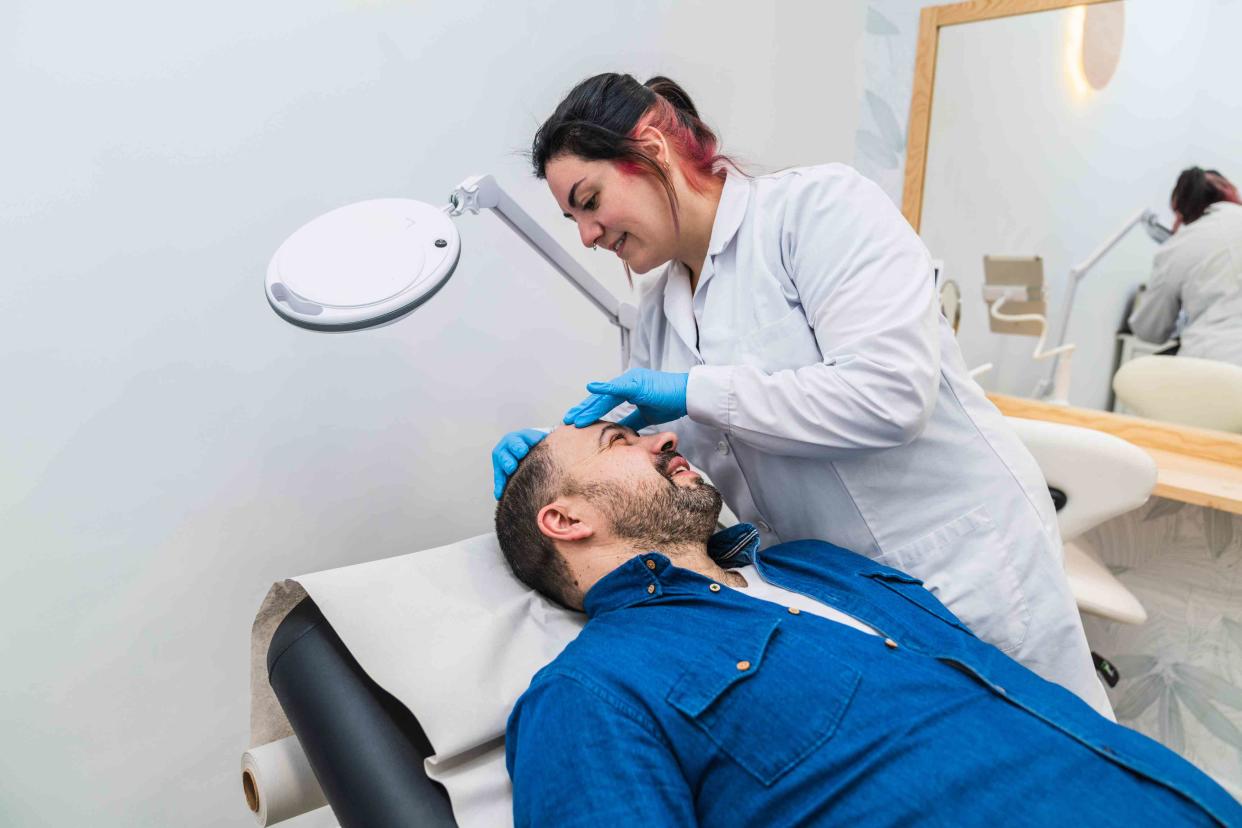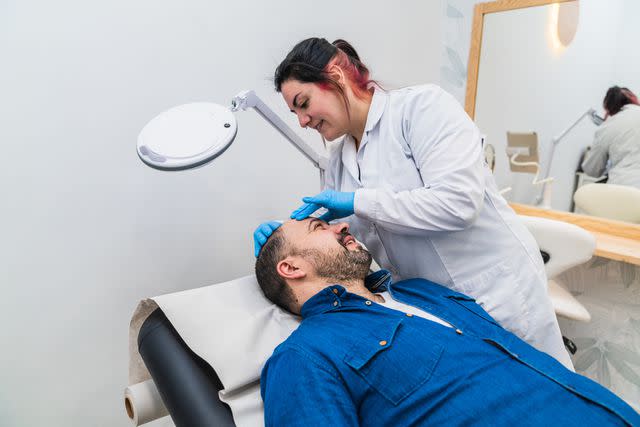The Goal of Lichen Planopilaris Treatment

Lichen planopilaris is an itchy skin rash that affects your scalp. It is a rare follicular form of lichen planus, an inflammatory disease that affects the skin and mucous membranes. These ailments occur because of a faulty immune response that causes your body to attack its own tissues.
Lichen planopilaris can affect the way you look and feel. Symptoms can include itching and burning. Patches of scarring can cause permanent hair loss in affected areas. The ailment can impact your mental health if it makes you feel anxious about how you look.
A cause and cure for this ailment does not exist. First-line treatment includes topical and/or oral corticosteroids. Other drugs and treatments are also used.
This article describes lichen planopilaris symptoms, treatment, risk factors, and resources.

Lichen Planopilaris vs. Lichen Sclerosus
Lichen planopilaris and lichen sclerosus are both regarded as immune-related diseases that share many features. Both conditions can cause intense itchy areas on your skin. First-line treatment for both conditions involves the use of corticosteroids. These conditions differ in the areas they affect. While lichen planopilaris usually involves your scalp and hair, lichen sclerosus usually involves your genital and anal areas.
Symptoms of Lichen Planopilaris
Symptoms of lichen planopilaris can vary by individual. They can differ depending on where they appear on your body. There are three types of lichen planopilaris that involve slightly different patterns and locations of symptoms:
Classic Lichen Planopilaris: Bald patches on your scalp
Frontal Fibrosing Alopecia:
Bald patches and scarring at your hairline near your forehead
Bald patches and scarring, possibly on eyelashes or eyebrows
Lassueur-Graham-Little-Piccardi Syndrome:
Bald patches on your scalp
Thinning hair in your armpits and groin
Rough bumps around hair follicles
The following general symptoms can occur in all types of lichen planopilaris:
Scaly, shiny patches of skin
Redness and inflammation around hair follicles (shafts on the surface of your skin that hair grows through)
Bald patches on your scalp
Pain, burning, or itching on your scalp
Papules (tiny, red bumps) around hair clusters
Scarring that leads to permanent hair loss (cicatricial alopecia)
Is Lichen Planopilaris the Same as Alopecia Areata?
Lichen planopilaris is a form of scarring alopecia that destroys hair follicles, causing scarring and permanent hair loss. it usually occurs only in the affected patches of the scalp and/or surrounding area.
Alopecia areata can occur anywhere in an area of hair-bearing skin and often involves the scalp and beard. It causes discrete circular patches of hair loss but total hair loss may uncommonly occur as well. While lichen planopilaris causes permanent hair loss, hair loss caused by alopecia areata usually regrows entirely within one year without treatment.
Goal of Lichen Planopilaris Treatment
A diagnosis of lichen planopilaris may be made by your primary care provider or after referral to a dermatologist (a medical doctor specializing in diagnosing and treating skin, hair, and nail conditions).
A diagnosis of lichen planopilaris is made using the following procedures:
Physical examination that also includes taking a medical history
Discussion of symptoms and visual inspection of the affected region
Dermoscopy: (examination of the affected area using a special lighted, magnified lens called a dermatoscope)
Wood’s lamp examination (examination of this affected area using ultraviolet light to examine the change in skin pigmentation)
Skin biopsy (removal of a small sample of affected skin for laboratory analysis)
There is no cure for lichen planopilaris. If you receive a diagnosis of lichen planopilaris, your dermatologist may advise that treatment begin as soon as possible since early treatment can reduce your risk of hair loss. While some cases of lichen planopilaris may resolve independently, others progress rapidly and may take longer to resolve. It is also possible for the condition to recur after successful treatment.
The goal of lichen planopilaris treatment is to achieve the following:
Decrease the rate of hair loss
Control pain, discomfort, and other symptoms that may cause significant distress
Reduce symptoms of inflammation
Promote hair regrowth when needed
Treatment for lichen planopilaris usually continues until the following is accomplished:
Clearing of itching, burning, pain, and tenderness
Lack of scalp redness, scaling, and/or pustules
Lichen Planopilaris Drug Treatment
Lichen planopilaris drug treatment includes several options. Since the course of this condition is often prolonged, treatment often lasts from six to 12 months.
There is no gold standard for treating this condition. Many drugs used to treat lichen planopilaris are primarily intended for other conditions but have demonstrated effectiveness in treating this disease. These medications include the following:
Ointments containing high-potency topical corticosteroids (first-line treatment)
Steroid injections into skin lesions
Oral corticosteroids if topical medication is ineffective
Topical calcineurin inhibitor including Protopic (tacrolimus) and Elidel (pimecrolimus)
Plaquenil (hydroxychloroquine) (a malaria medication)
Rituxan (rituximab) (a medication for cancerous and inflammatory illnesses)
Immunosuppressant medications including CellCept (mycophenolate mofetil) and Gengraf (oral cyclosporine)
Rheumatrex (methotrexate) (a medication used for autoimmune conditions such as rheumatoid arthritis and psoriatic arthritis, as well as cancer)
Contergan (thalidomide) (a medication for cancer)
Retinoids (a medication for acne) including Retin-A (tretinoin topical) and Tazorac (tazarotene topical)
Actos (pioglitazone) (a medication used for diabetes)
5-alpha reductase inhibitors (medications for prostate gland enlargement) including Proscar (finasteride) and Avodart (dutasteride)
Oral or topical Rogaine (minoxidil) to increase new hair growth
Topical and systemic Janus kinase (JAK) inhibitors such as Opzelura (ruxolitinib) or Rinvoq (upadacitinib)
Learn More: Our 10 Hair Loss Treatment Picks for Balding or Thinning Hair
Corticosteroid Shampoo for Lichen Planopilaris
Corticosteroids are frequently used in treating lichen planopilaris. In addition to topical, oral, and injectable treatments, steroids can be delivered via shampoo. Clobex (clobetasol proportionate) is a steroid shampoo used to treat lichen planopilaris. To achieve optimal results, it is important to follow the product's steps, as follows:
Move the hair away from the scalp so that one of the affected areas is exposed.
Apply Clobex onto dry (not wet) scalp once daily in a thin film to the affected areas only.
Allow Clobex to remain in place for 15 minutes before lathering and rinsing.
Wash your hands thoroughly after using the shampoo.
Lichen Planopilaris Nondrug Treatment
Lichen planopilaris nondrug treatment involves using natural and over-the-counter therapies to help improve symptoms. Try these treatments to treat lichen planopilaris:
Herbal topical treatment with tulsi—also known as holy basil—or tumeric
Coconut oil
Aloe vera
Vitamin D supplements
Cream or shampoo containing ketoconazole
Cosmetic options for covering hair loss include hair-thickening, color-matched keratin protein fibers, wigs, powder scalp coloring that matches your hair color, and hair crayons that color your scalp to match your hair color
Mental health counseling for loss of confidence, depression, or anxiety, which can commonly occur with a chronic disease
Avoiding the following products may help reduce symptoms of itching and irritation:
Hair coloring, especially colors and dyes that contain ammonium persulfate, paraphenylenediamine (PPD), and methylchloroisothiazolinone (MCI/MI)
Chemical hair treatments
Shampoos that contain sulfates
Hair care products such as gallate mix, dodecyl gallate, octyl gallate, zinc (commonly found in products with SPF), fragrances, and formaldehyde releasers
Learn More: The 7 Best Shampoos for Thinning Hair in 2023
What Causes, Triggers, and Increases Lichen Planopilaris Risk?
There is no known cause or cure for lichen planopilaris. Research indicates that the disease may be an immune system disorder. Women and people between 40 and 60 years are most likely to develop this condition.
You have an increased risk of developing lichen planopilaris if you have any of the following factors that may trigger the condition:
Exposure to certain pigments and metals
Use of nonsteroidal anti-inflammatory drugs (NSAIDs) such as Advil (ibuprofen) and Aleve (naproxen)
Hepatitis C virus infection
Some medications for high blood pressure
Medications for arthritis
History or certain cosmetic procedures like hair transplant surgery or rhytidectomy (face-lift)
Lichen Planopilaris Resources
After a diagnosis of a rare condition like lichen planopilaris, it is common to feel frustrated by a lack of available information. Many groups work to fill the void of awareness by providing online and in-person support, education, and advocacy for people with this disease. Search online for podcasts and blogs that discuss strategies for coping and treatment.
Consult your healthcare provider for references to local organizations involved in lichen planopilaris. Online support is available from the following groups:
Texas A&M School of Dentistry online International Oral Lichen Planus Support Group: A web-based support group that serves people with this diagnosis and their loved ones worldwide
Texas A&M Lichen Planus Webcasts: A series of recorded webcasts with medical specialists in the field of lichen planus treatment
Lichen Planus Support Group: Private Facebook-based support group, with membership open to anyone with this diagnosis or their loved ones
Scarring Alopecia Foundation (SAF): An organization with a mission of providing virtual support for lichen planopilaris and all types of scarring alopecia disorders
Summary
Lichen planopilaris is a skin disease that can lead to permanent patchy baldness. The ailment causes an itchy skin rash on your scalp. It can also affect your hairline, eyebrows, and eyelashes in some cases.
While this ailment has no known cause, research shows it may be linked to problems with your immune system. Treatments can't cure this ailment but they can help treat symptoms like itching, burning, and inflammation. Treating symptoms is key to easing the emotional effects of this disease, which can lead to depression and anxiety. Getting emotional support is also an essential aspect of living with this ailment.
Most cases of lichen planopilaris clear within about a year, though the problem can recur. Hair replacement treatments may help you restore hair lost to this ailment.

